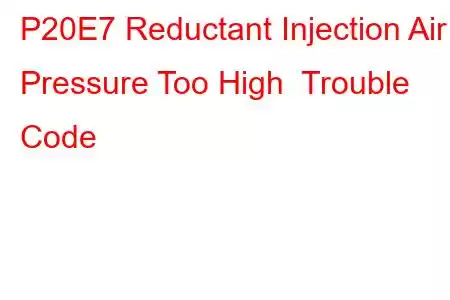P20E7 Reductant Injection Air Pressure Too High
OBD-II Trouble Code Technical Description
Reductant Injection Air Pressure Too High
What does that mean?
This diagnostic trouble code (DTC) is a generic powertrain code and applies to many OBD-II vehicles (1996-newer). That may include but is not limited to vehicles from BMW, Mercedes-Benz, Dodge, Sprinter, etc. Although generic, the exact repair steps may vary depending on year, make, model and powertrain configuration.
A stored code P20E7 means that the powertrain control module (PCM) has detected an excess reductant injection air pressure.
The catalyst system is responsible for reduction of (basically) all exhaust emissions although certain applications are also equipped with a NOx trap.
Exhaust gas recirculation (EGR) systems go another step further in the reduction of NOx. Nevertheless, today's larger and more powerful diesel engines cannot meet strict federal (U.S.) emission standards with the EGR, diesel particulate filter/catalytic converter, and NOx trap alone. It was for this reason that selective catalytic reduction (SCR) systems were invented.
SCR systems inject a reductant compound or a diesel exhaust fluid (DEF) into the exhaust in front of the diesel particulate filter, NOx trap, and/or the catalytic converter via the reductant injection valve (solenoid). The precisely timed DEF injection elevates the temperature of the filtration element and allows it to perform more efficiently. It enhances filtration element longevity and allows fewer harmful exhaust emissions to be released into the atmosphere. The entire SCR system is monitored and controlled by either the PCM or a stand-alone controller (which interacts with the PCM). Either way, the controller monitors the O2, NOx, and exhaust temperature sensors (as well as other inputs) to determine the appropriate time for DEF (reductant) injection. Precise DEF injection is necessary to maintain exhaust temperature within acceptable parameters and optimize pollutant filtration.
The reductant/regeneration supply pump is used to pressurize the DEF in the liquid reductant system for use, when required. Supply pump voltage is monitored by the PCM for consistent fluctuation and load percentage. The PCM also monitors one or more pressure sensors in the reductant supply system to determine if there is a leak in the system.
If the PCM detects abnormally high reductant injection air pressure, a code P20E7 will be stored and a malfunction indicator lamp (MIL) may be illuminated. Multiple ignition cycles - with a failure - may be required for MIL illumination.
What is the severity of this DTC?
A stored code P20E7 should be considered severe and addressed as quickly as possible. The SCR system could be disabled because of it. Catalyst damage could result if the conditions which contributed to the code being stored are not rectified in a timely fashion.
What are some of the symptoms of the code?
Symptoms of a P20E7 trouble code may include:
Reduction in fuel efficiency Excessive black smoke from vehicle exhaust Diminished engine performance Other SCR related codesWhat are some of the common causes of the code?
Causes for this code may include:
Too high of reductant injection air pressure Defective reductant injection air pressure sensor Open or shorted circuits in the reductant injection air pressure sensor system Bad SCR controller/PCM or programming errorWhat are some P20E7 troubleshooting steps?
Make sure that the reductant/regeneration supply system is not losing pressure (internally or externally). Activate the pump to create pressure and inspect the system for external leaks. Use a fuel pressure tester to monitor reductant system pressure manually. Check the supply pump and the injector for leakage. If leaks are discovered (internal or external), they must
Read: 23


